Crash Course In Flieger (Pilot) And B-Uhren (Navigator) Watches Covering Both Historic And Modern Examples: Pilot’s Watch Photofest!
by Bhanu Chopra
A “flieger” is a pilot or aviator-style watch. The majority of modern flieger watches are inspired by the now-iconic German B-Uhren and pilot’s watches of World War II.
As fliegers (as I like to call them) have become a genre unto themselves rather than a narrow definition of a type of pilot’s watch, I figured it was time for a crash course in the topic.
I begin at the beginning with the B-Uhren that were worn by a plane’s navigators, followed by the flieger chronographs issued to the pilots, and finish with a brief overview of noteworthy modern German-style pilot’s watches that were inspired by the historical fliegers.
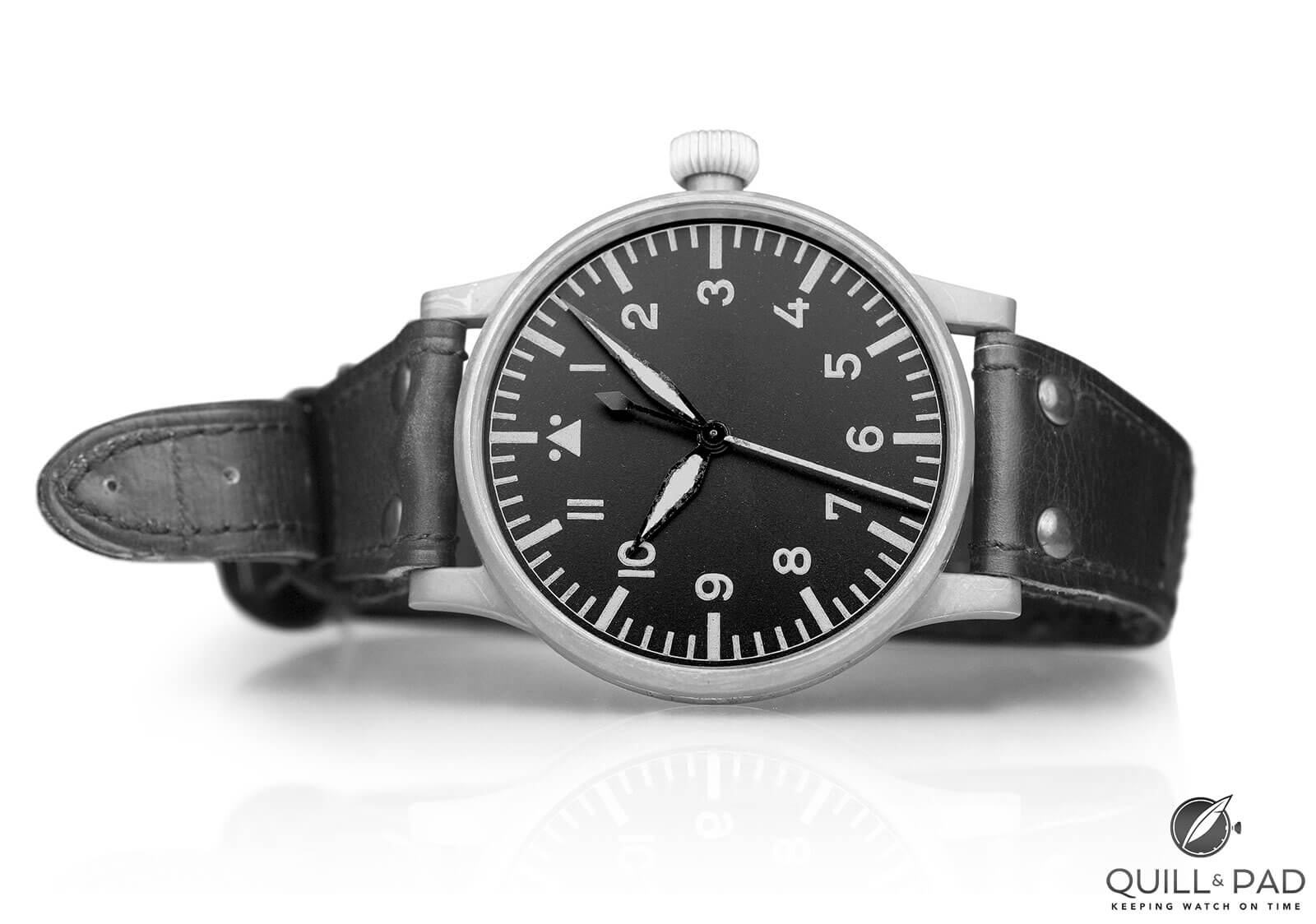
An original 1939 Type A Stowa B-Uhr
Like maritime navigation, aviation required precise timekeeping to determine geographical longitude and later a host of other functional elements. Precise, robust, and highly legible watches were the order of the day for determining aircraft location and flight duration.
These early watches were known as Beobachtungsuhren – B-Uhren (“observation watches”) in their abbreviated form. B-Uhren, in combination with an octant (angle), were used as navigation instruments during flight for determining the precise position of the aircraft. Pilots usually wore chronographs as a backup should the cockpit clock fail.
B-Uhren were manufactured in two different types of dial configurations as follows.
Type A (Baumuster A): manufactured from 1940 through January 1941 with a classic dial featuring numerals 1 to 11. Instead of a 12 at the top, there was a triangle marker with a dot on either side.
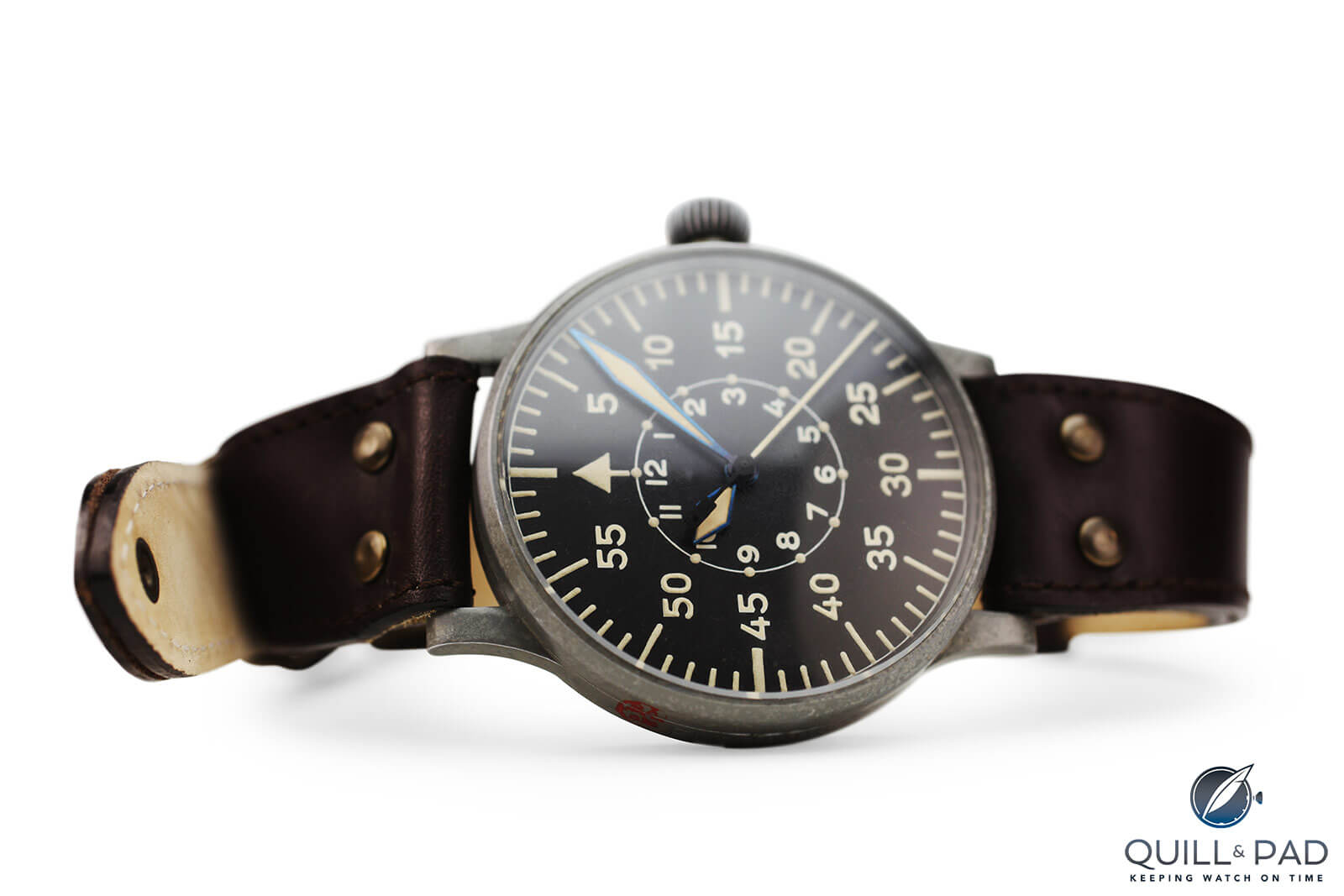
An original 1942 Type B Stowa B-Uhr
Type B (Baumuster B): manufactured from January 1941, this dial had large minute numerals from 5 to 55 on a chapter ring around the periphery and a small sub-chapter ring with hour numerals.
Characteristics of a B-Uhr
The Reichluftfahrtsministerium (RLM), the “Ministry of Aviation” in 1933-1945 Germany, defined strict specifications for B-Uhren for both Type A and Type B watches as follows.
Case size: The watch movements were uniformly encased in 55 mm, gray-varnished, brass or steel cases with snap-on case backs. Printed on the inside of the case back was the type, device and movement number, stock number, and the producer’s name.
Crown: These watches included a large oignon-shaped crown so that navigators could operate the watches without taking off their gloves.
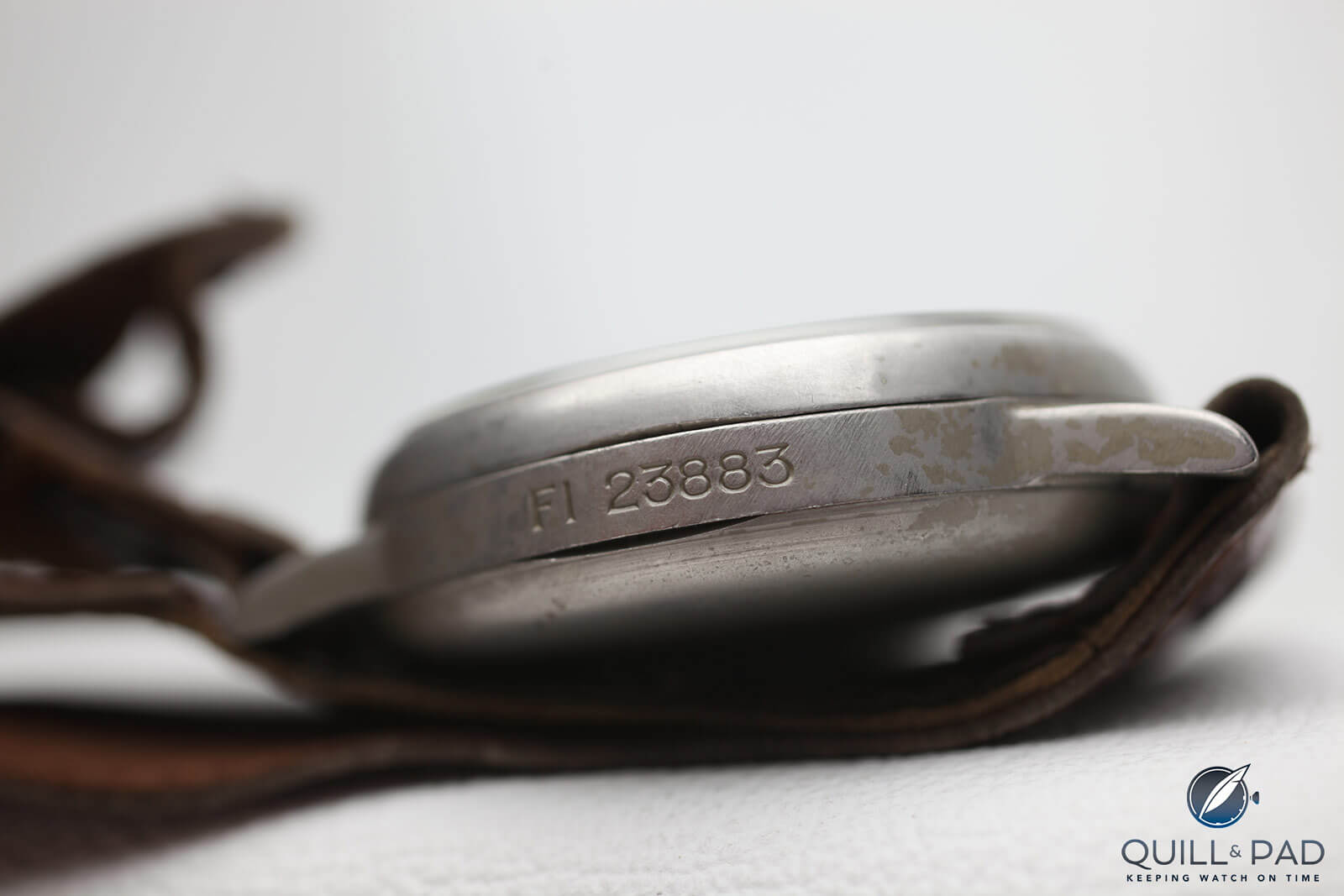
Original Wempe B-Uhr with FL 23883 marking (photo courtesy Jörg Schauer)
Official FL 23883 marking: “FL” stands for “Flight” (Flug), the first two digits, “23,” stand for navigation, and “883” was a code assigned by the German Testing Office for Aeronautics.
Triangle marker at 12’o clock: The 12 o’clock indicator was marked with a triangle and two dots so that it could be differentiated from other numerals at a quick glance. The other reason was for pilots to quickly determine the watch’s upward orientation.
Luminescence: A strong radium (226Ra) paint was used for luminescence so that the dial could be read off in darkness. The luminous material was applied to large Arabic numerals and the minute and second markers. The hour, minute, and second hands were also coated with the radioactive paint.
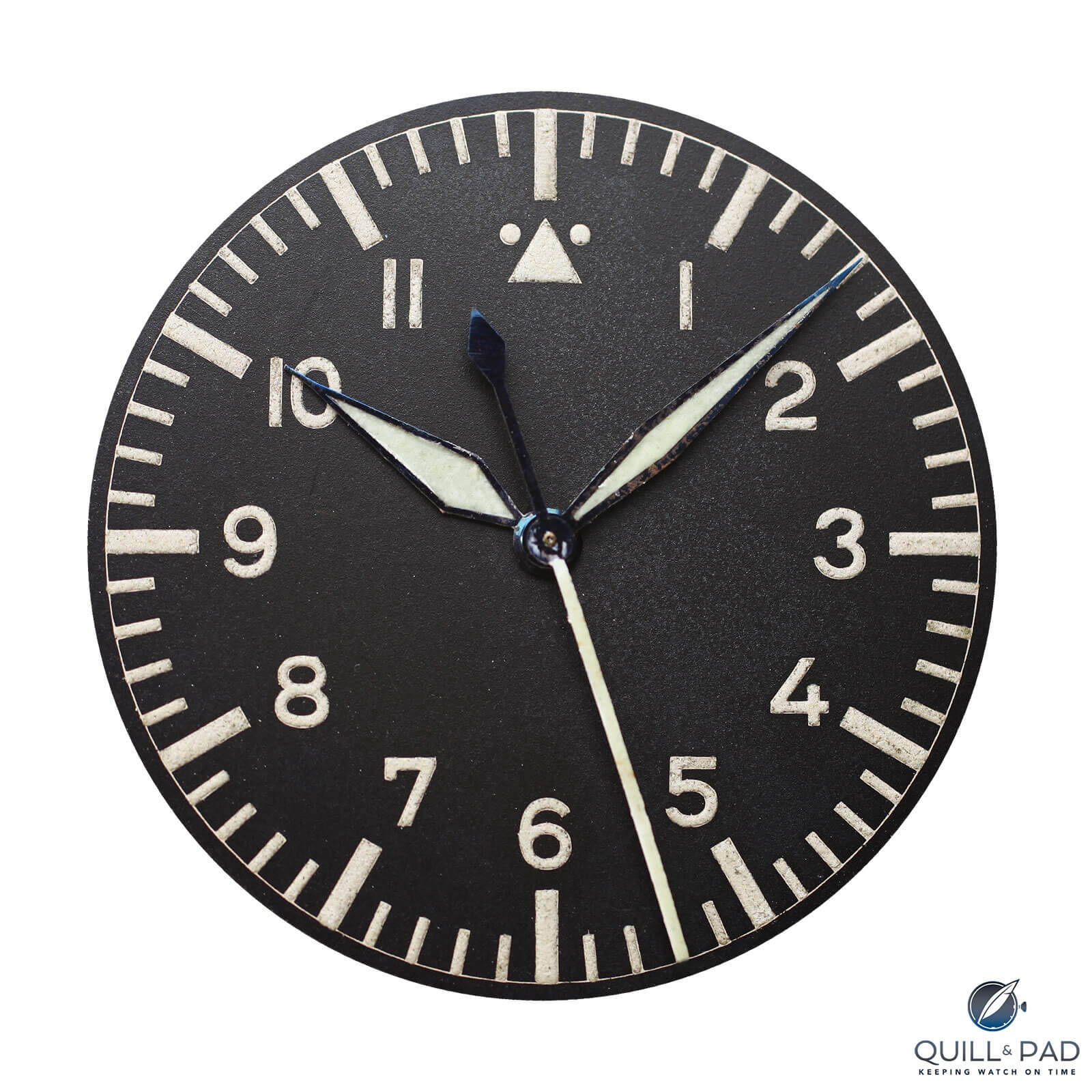
Historic Type A B-Uhr dial from 1939
Hacking movement: B-Uhren had a central second hand driven outside the power flow and a stop-balance function for accurate time setting. This “hack” feature (temporarily stopping the movement’s gear train/mainspring) facilitated crew/flight synchronization between aircraft participating in a given mission.
Certified chronometer: The Luftwaffe (“air force”) High Command provided exact instructions regarding operating precision and the degree of movement completion required. Before delivery, every single watch had to be tested and certified by the German Naval Observatory. The fine adjustment of each watch was conducted in six positions and at three different temperatures. B-Uhren were regulated as navigational timepieces and individually tested for chronometer quality.
Balance spring with Breguet overcoil: A Breguet overcoil was used by the major watch manufacturers at the time to maximize the isochronism (regularity) of the balance for improved precision.
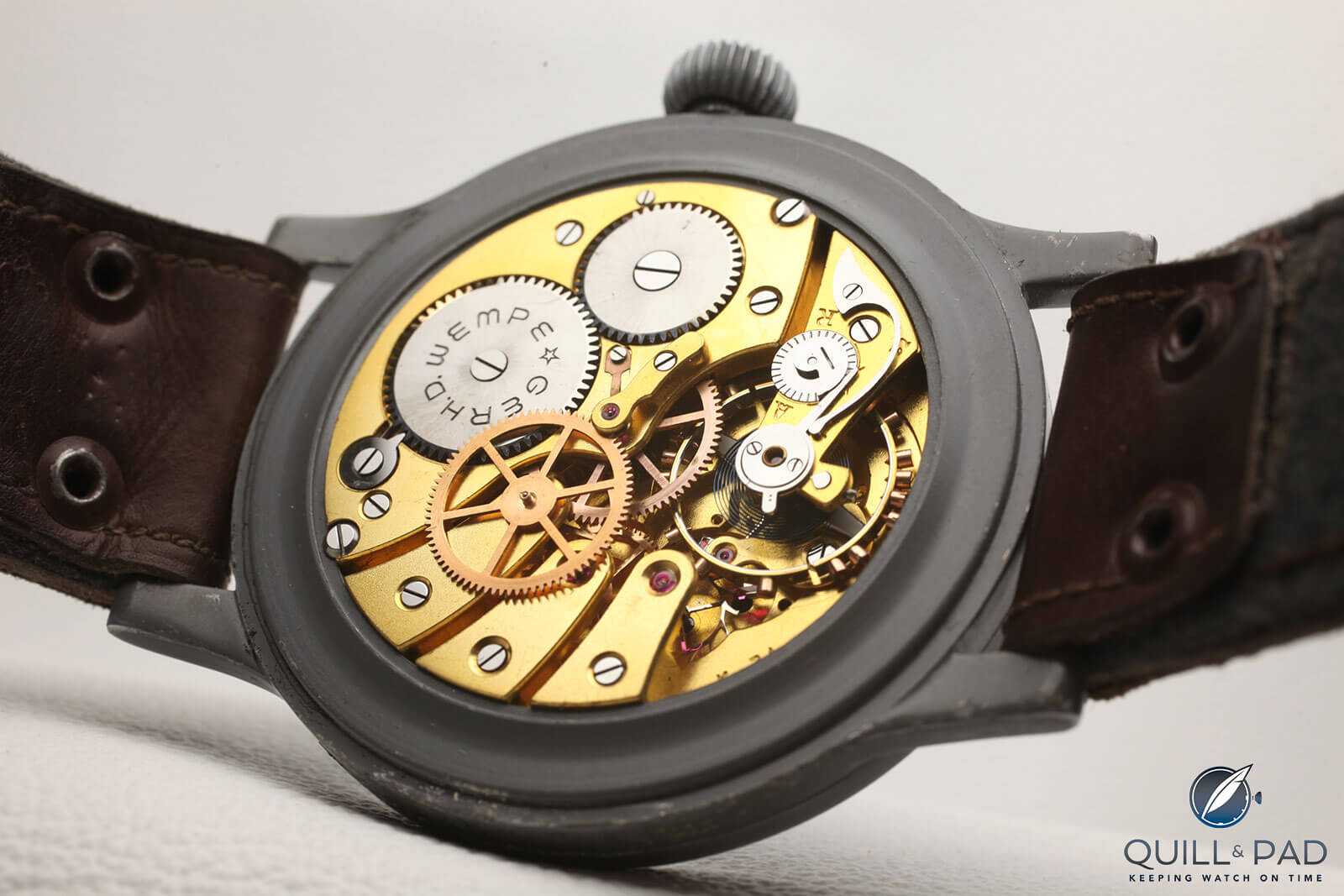
Revue Caliber 31 in an original Wempe B-Uhr (photo courtesy Jörg Schauer)
Long strap: Extra-long, riveted straps expressly made to wear over shearling flight jacket sleeves were required. Although some of the original five B-Uhren makers have added the anecdotal marketing story that navigators would sometime wear the watch over their ankles – and the urban legend of pilots wearing them around their thighs has long been in existence – there is no proof of it.
—————————————————————————————————–
—————————————————————————————————–
The original five B-Uhren
Only five companies manufactured the original B-Uhren for the Luftwaffe.
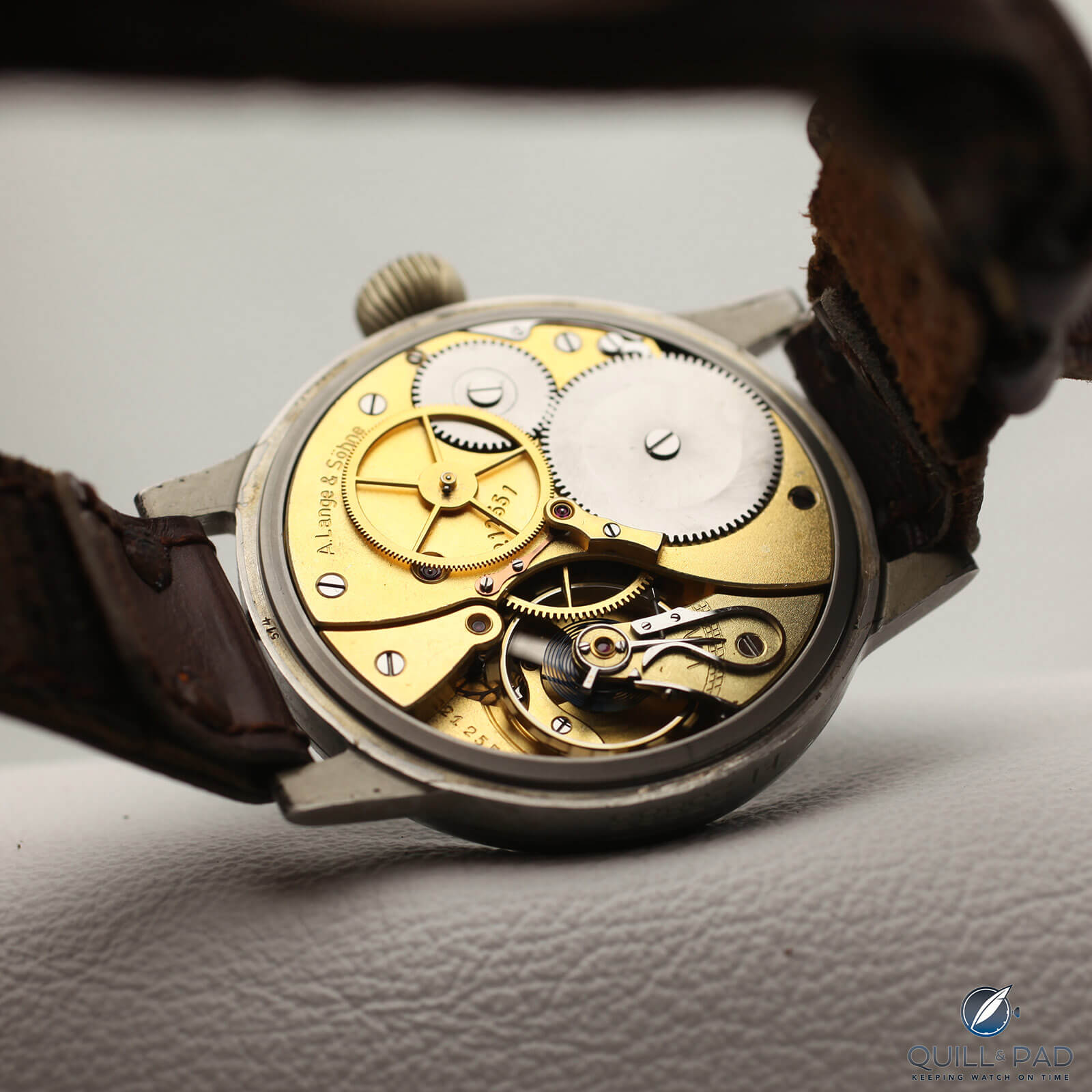
A. Lange & Söhne B-Uhr Caliber 481 (photo courtesy Jörg Schauer)
A. Lange & Söhne – Lange produced a total of 6,904 watches between 1940 and 1945. Due to limited capacity, watches were assembled by Huber in Munich, Felsing in Berlin, Schieron in Stuttgart, Schätzle & Tschudin in Pforzheim, and Wempe in Hamburg.
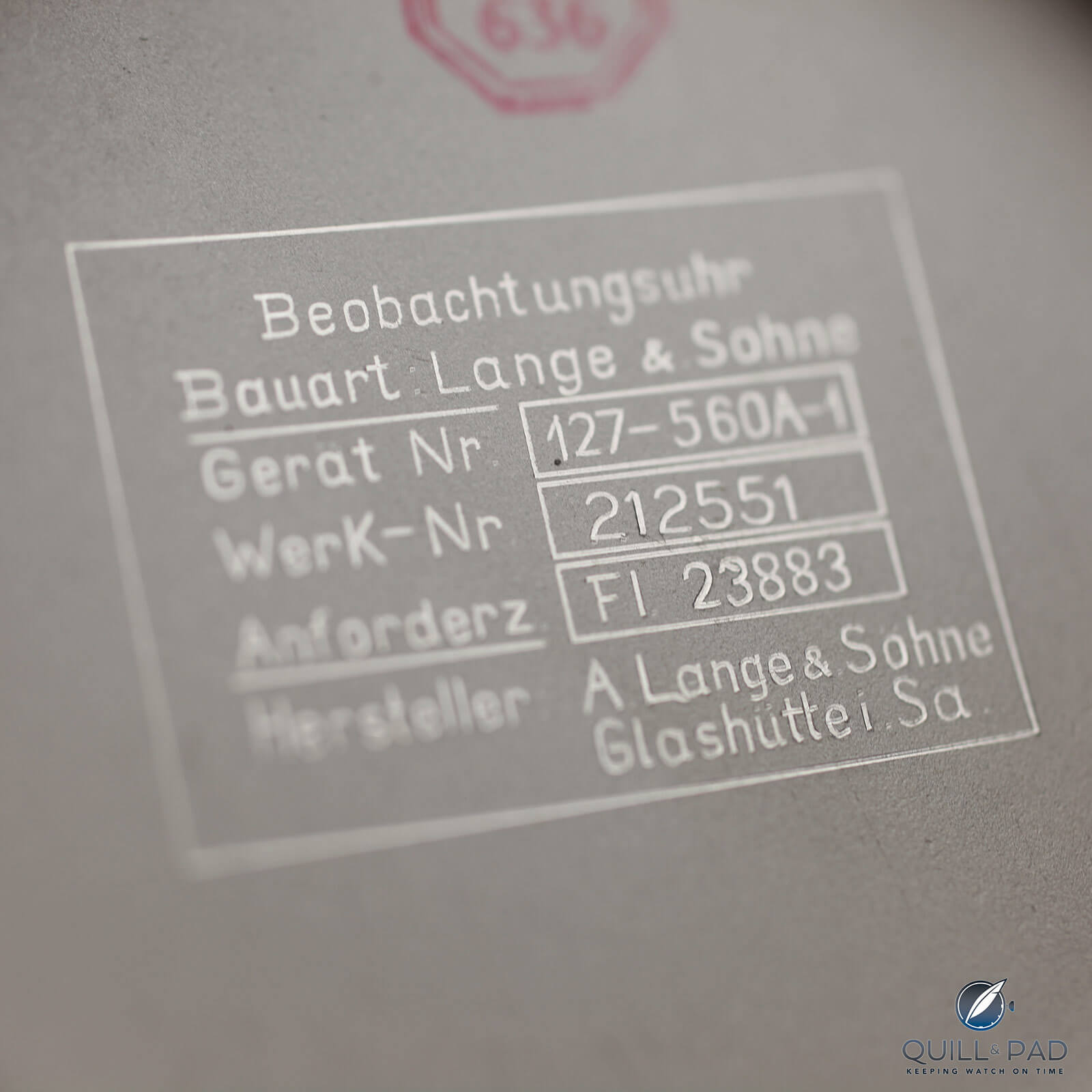
Inside the case back of an A. Lange & Söhne B-Uhr (photo courtesy Jörg Schauer)
To avoid turning their factories into bombing targets, from 1944 manufacturer’s names were no longer engraved, so the A. Lange & Söhne name was replaced by the code “nhk.”
Historical side note: Caliber 48.1 was subsequently taken over by the East German Glashütter Uhrenbetrieb combine after the war, which continued to manufacture it until 1971.
Quick Facts A. Lange & Söhne B-Uhr
Case: 55 x 20 mm, steel
Movement: manually wound Caliber 48.1 with bi-metallic (nickel/steel) Guillaume balance with gold screws, hacking stop-seconds, Glashütte two-thirds plate, movement dimensions 48 x 8.5 mm, Breguet overcoil, 16 jewels, no shock protection, swan-neck fine adjustment, 35-hour power reserve
Functions: hours, minutes, center seconds
Years of manufacture: 1940–1945
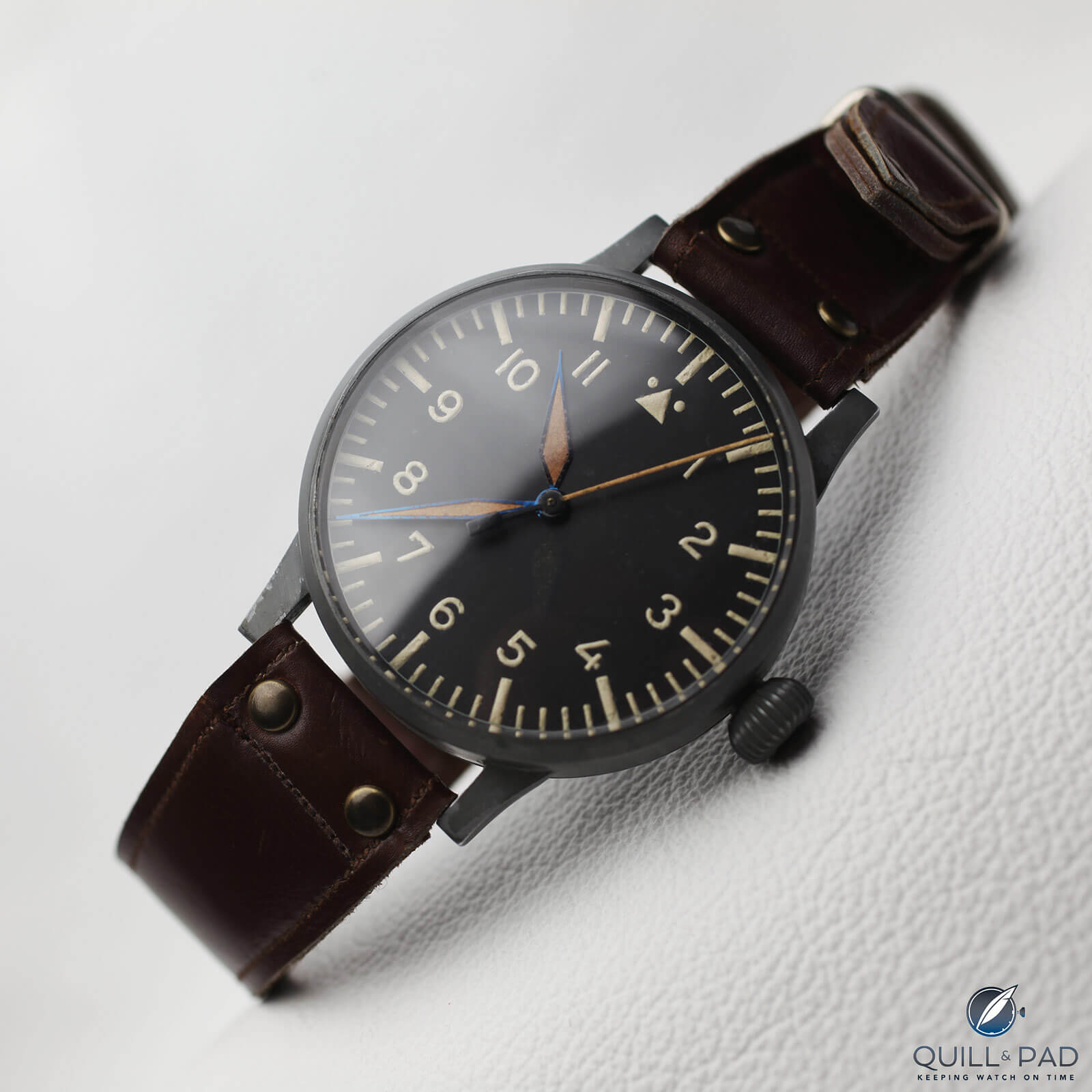
Laco B-Uhr (photo courtesy Jörg Schauer)
Laco (Lacher & Co) – This Pforzheim manufacturer used the large Durowe D5 pocket watch movement in its B-Uhren, which has a considerably large balance wheel and simple index regulation. The Durowe D5 was manufactured until 1945. Approximately 6,500 of these watches were manufactured.
Quick Facts Laco B-Uhr
Case: 55 x 21 mm, steel
Movement: manually wound Caliber Durowe D5 with large Guillaume balance, hacking stop-seconds, movement diameter 49.4 mm, 22 jewels, no shock protection, Breguet overcoil
Functions: hours, minutes, center seconds
Years of manufacture: 1940–1945
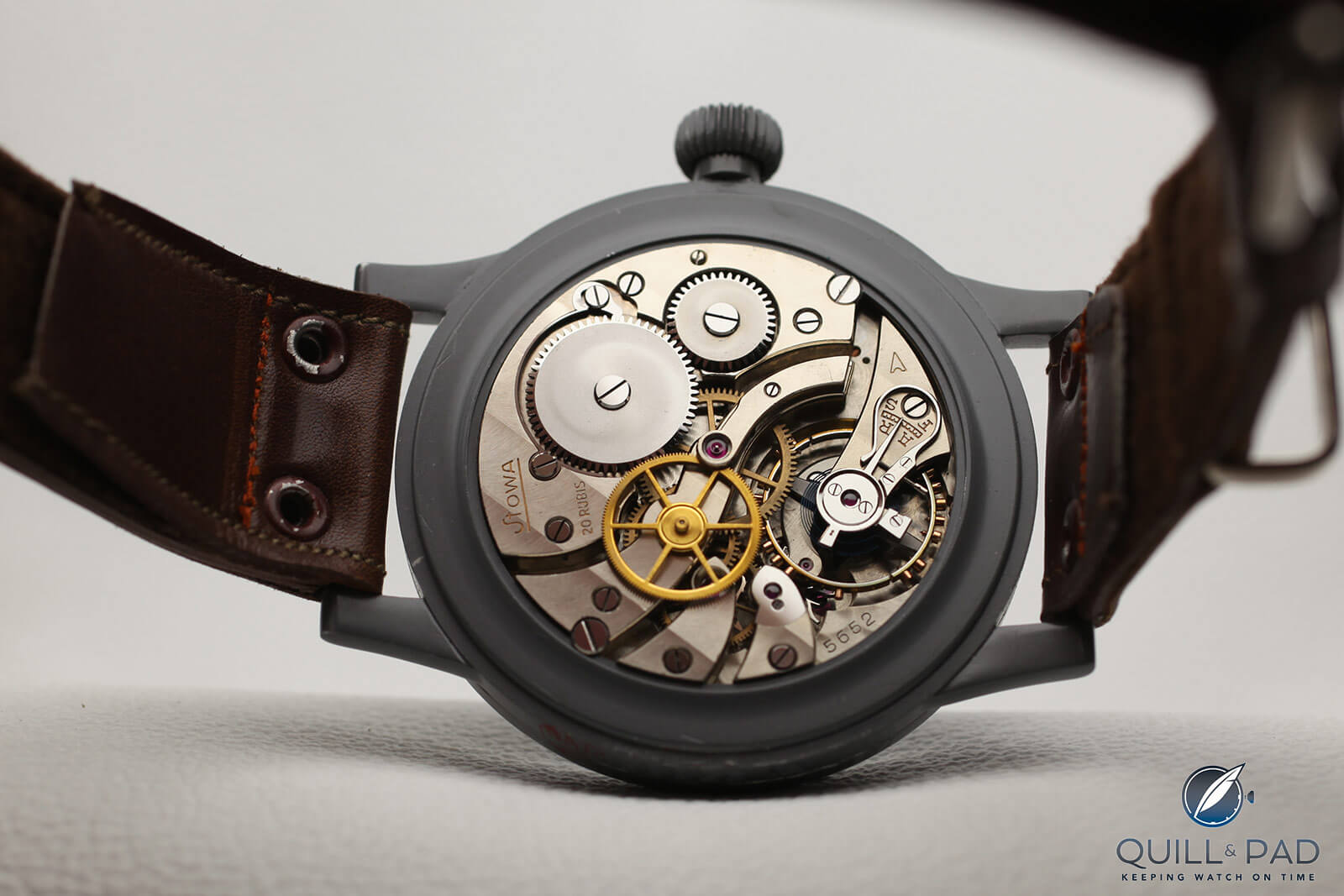
The Unitas 2812 movement powering the Stowa B-Uhr (photo courtesy Jörg Schauer)
Stowa (Walter Storz) – Walter Storz purchased Unitas 2812 movements from Switzerland to power his Stowa B-Uhren. Regulation was via large swan-neck fine adjustment. On February 23, 1945, the Stowa factory was destroyed by the British bombardment of Pforzheim.
Quick Facts Stowa B-Uhr
Case: 55 x 17.3 mm, nickel-plated brass
Movement: manually wound Caliber Unitas 2812 with swan-neck fine adjustment, Guillaume balance, hacking stop-seconds, 20 jewels
Functions: hours, minutes, center seconds
Years of manufacture: 1940–1945
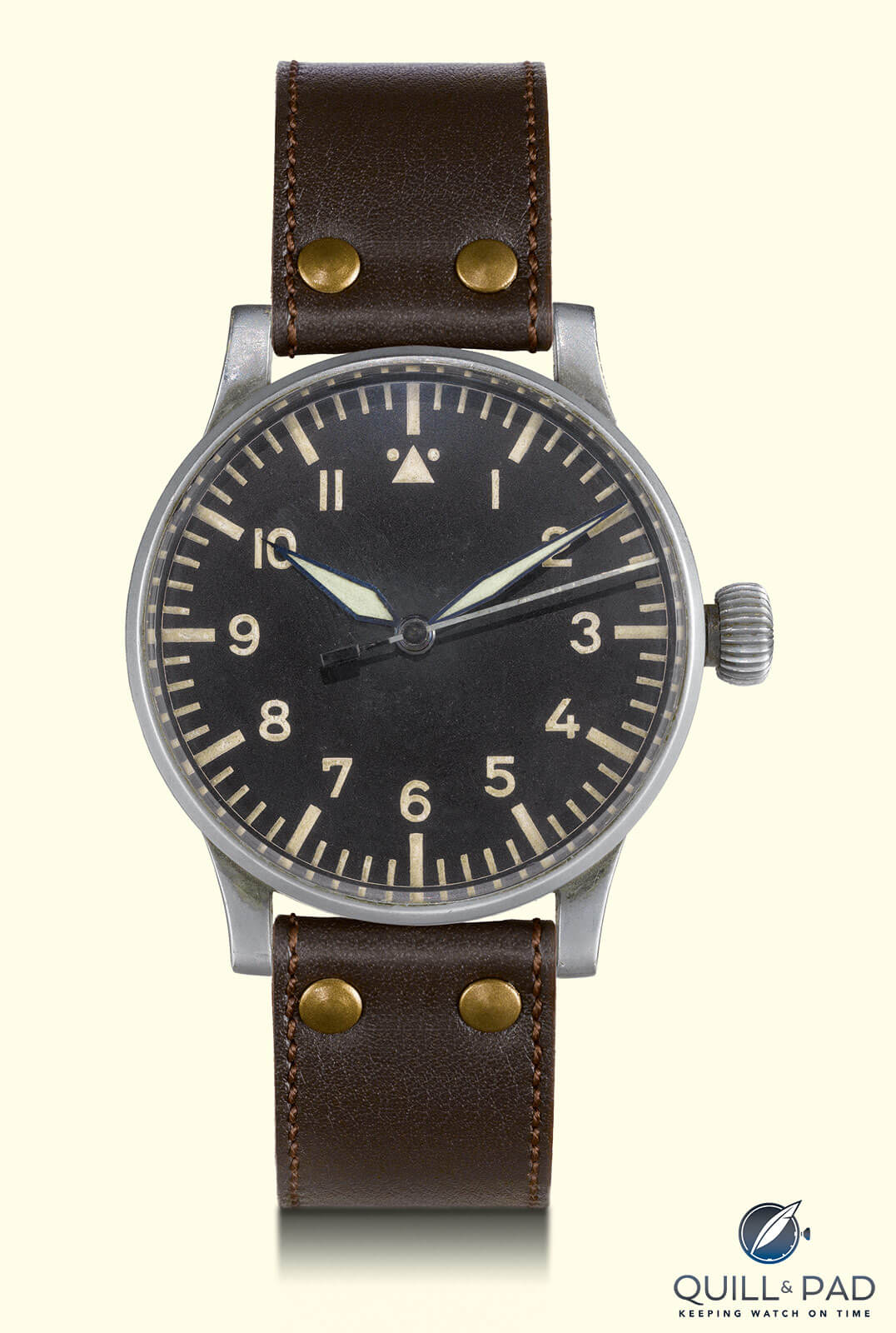
Wempe B-Uhr (photo courtesy Wempe)
Wempe (Chronometerwerke Hamburg) – The Wempe was fitted with a Revue Caliber 31 and is therefore known by collectors as the Wempe Carl Thommen Revue K 31 B-Uhr. Master watchmaker Buse in Mainz, Germany, an expert on World War II B-Uhren, once stated that only 60 watches were made. Due to their extreme rarity, they might command higher prices than the other four manufacturers if preserved in excellent condition.
Quick Facts Wempe B-Uhr
Case: 55 x 15 mm, nickel-plated brass
Movement: manually wound Swiss Caliber Revue 31 with bi-metallic balance, cam disk regulator, hacking stop-seconds, Glashütte three-quarter plate
Functions: hours, minutes, center seconds
Years of manufacture: 1940–1945
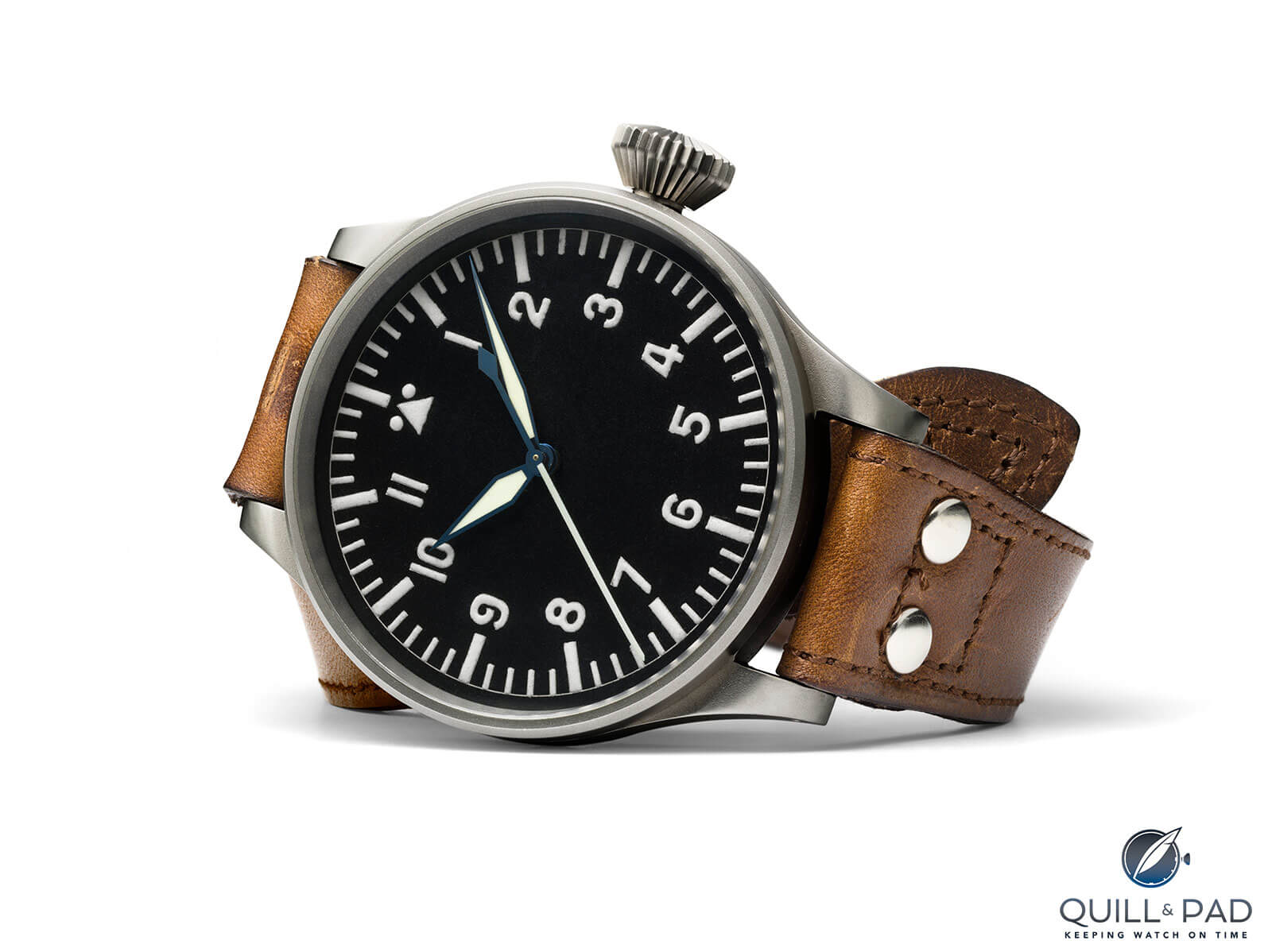
IWC B-Uhr (photo courtesy IWC)
IWC – A total of 1,200 Caliber 52 SC (officially: “52T-19”’ H6 S.C.”) movements were made in 1940, and around 1,000 went into the B-Uhren made by IWC. “SC” stands for “central seconds,” also known as the sweep seconds hand. The watch had an additional anti-magnetic inner case, an element IWC has carried throughout its history of robust sports watches.
Quick Facts IWC B-Uhr
Case: 55 x 17.5 mm, steel with inner anti-magnetic plate
Movement: manually wound Swiss Caliber 52 SC with bi-metallic balance, swan-neck fine adjustment, hacking stop-seconds
Functions: hours, minutes, center seconds
Year of manufacture: 1940
—————————————————————————————————–
—————————————————————————————————–
Flieger (pilot’s) chronographs
Unlike for the B-Uhr, there were no published specifications from the RLM for German Fliegeruhren. However, pilot chronographs were introduced to indicate time, the elapsed flight time using the rotating bezel with a marker, and the flyback mechanism for precise timing. Germans called this the Tempostopp back in the day; today we would definitely call it a flyback chronograph.
German pilots had an advantage in using the flyback feature to restart the chronograph function to coincide with a radio-transmitted signal, allowing them to calculate direction with maximum precision.
An alternate use for the flyback function came about during poor visibility, where the pilot must rely on instruments for flight by following course indications to the nearest second.
After World War I, Germany was prohibited from military aviation, so there were no official aviation watches produced. However, in the 1920s and 1930s there were pilot’s watches in circulation produced by Swiss makers such as Omega, Longines, and a few by IWC.
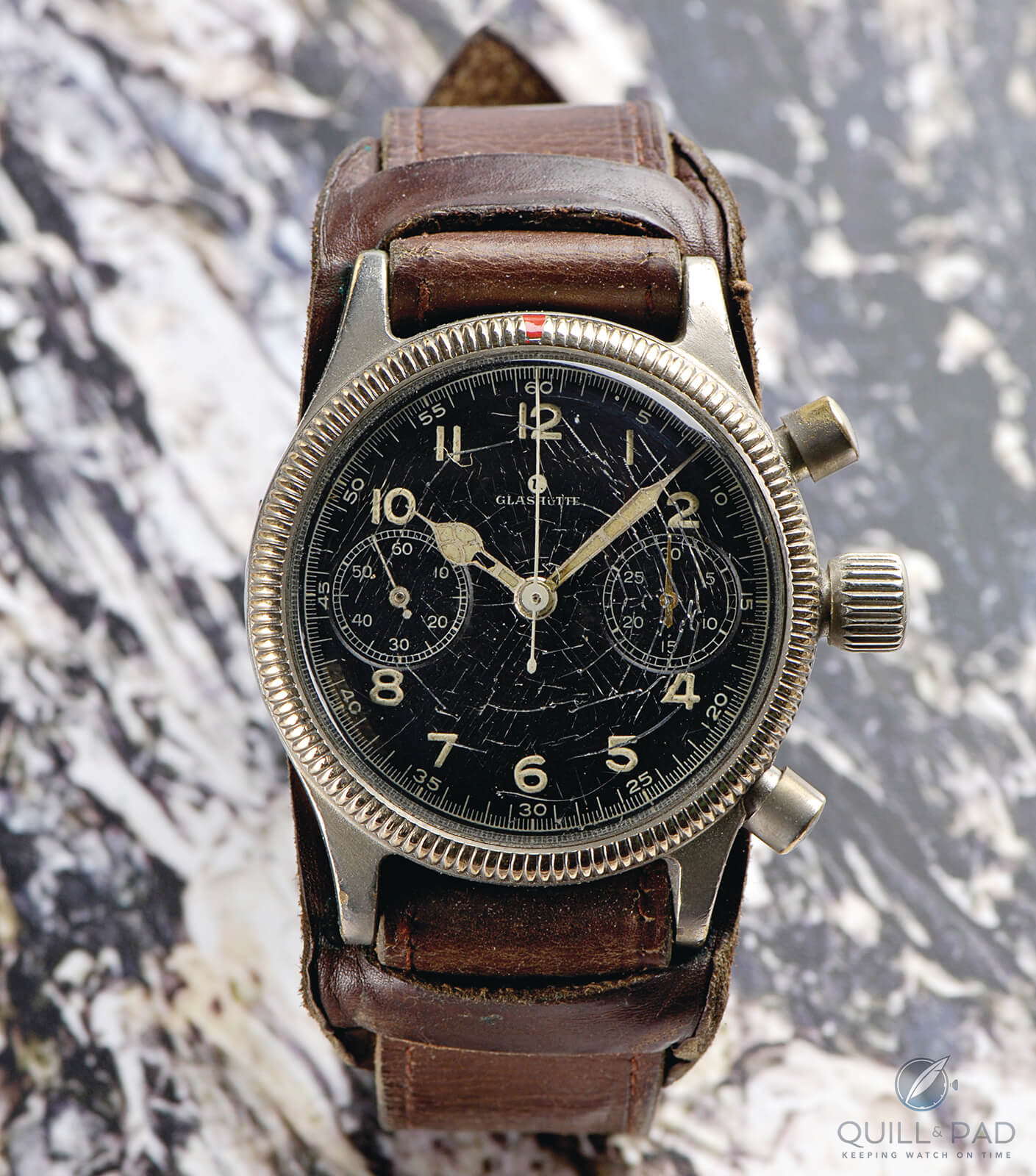
An original Tutima Glashütte pilot’s chronograph
By World War II, many of the chronograph wristwatches for the German air force were being produced in Germany by Tutima in Glashütte and Hanhart in Schwenningen (Black Forest). Hanhart first began producing aviator chronographs in 1938, while Tutima started in 1941.
The watches by both brands were similar in appearance, having a rotating bezel with a reference marker, and a flyback chronograph for timing up to 30 minutes; these watches did not display any military markings.
They also featured black dials with radium-coated luminous hands and Arabic numerals for easy reading in poor visibility. Early examples featured one-piece cases, with the lugs part of the case, while on later examples the lugs were soldered on to the case.
On most chronographs, the pusher for resetting the chronograph was coated in a red enamel so the wearer would not accidentally engage it.
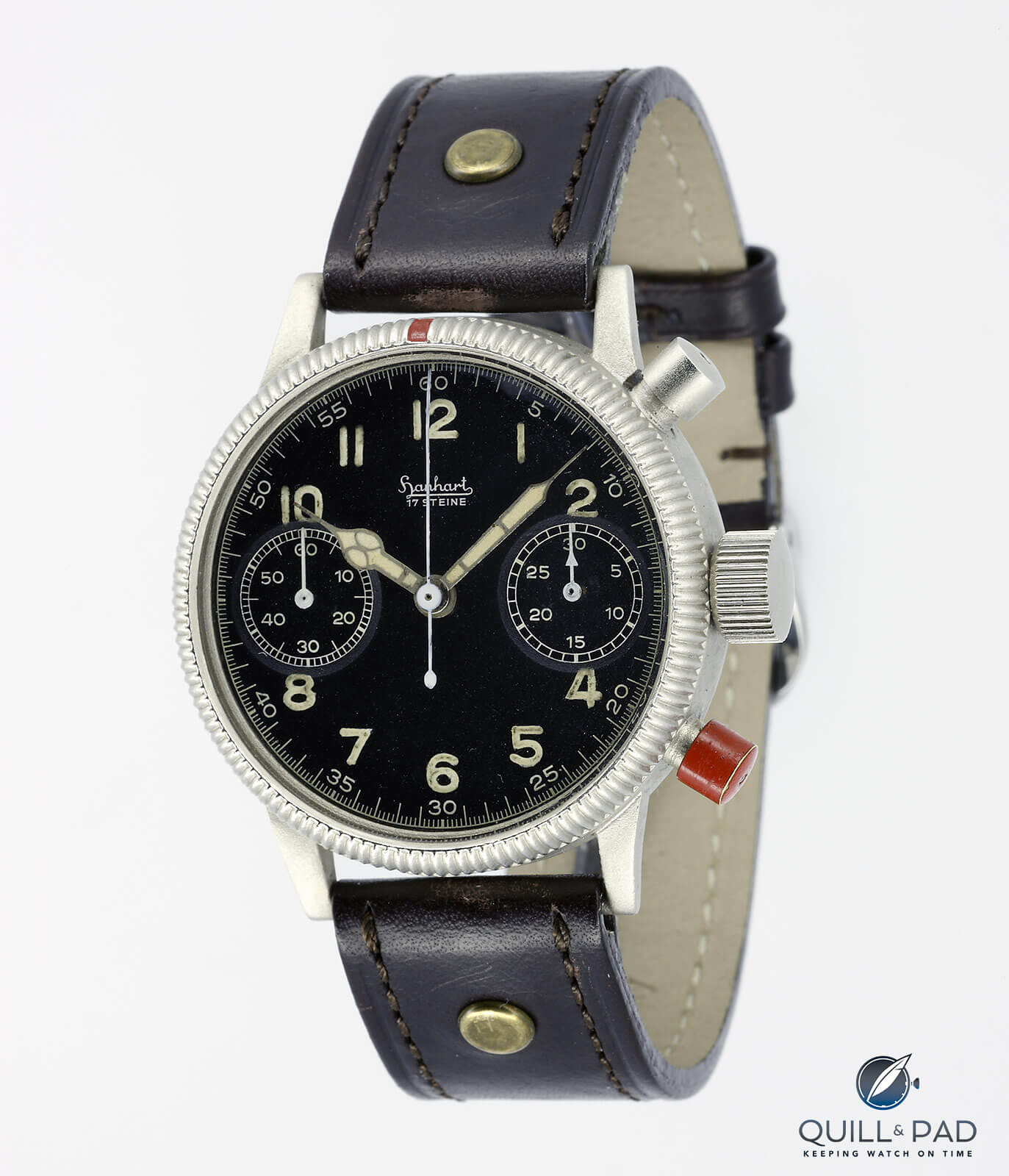
Hanhart Caliber 41 from 1939 (photo courtesy Hanhart)
Hanhart produced some of its flieger chronographs with a single pusher (monopusher) to control the start, stop, and reset functions. The monopusher fitted with Caliber 40 is considered much more collectible by aviation watch enthusiasts than the two-pusher chronograph fitted with Caliber 41.
Aside from the manufacturer’s name on the dial, the watches were also distinguishable by the asymmetry of the pusher – the top pusher on Hanhart watches touches the upper right lug, while the bottom pusher on Tutima watches touches on the lower right lug.
From 1939, Hanhart chronographs were issued to German air force pilots and naval officers during World War II.
Tutima was founded in 1927 by Dr. Ernst Kurtz, the managing director of Urofa/Ufag (Uhren-Rohwerk-Fabrik Glashütte AG). In the 1940s, Urofa/Ufag developed flyback chronograph Caliber 59 and used this movement in Tutima watches supplied to the German military.
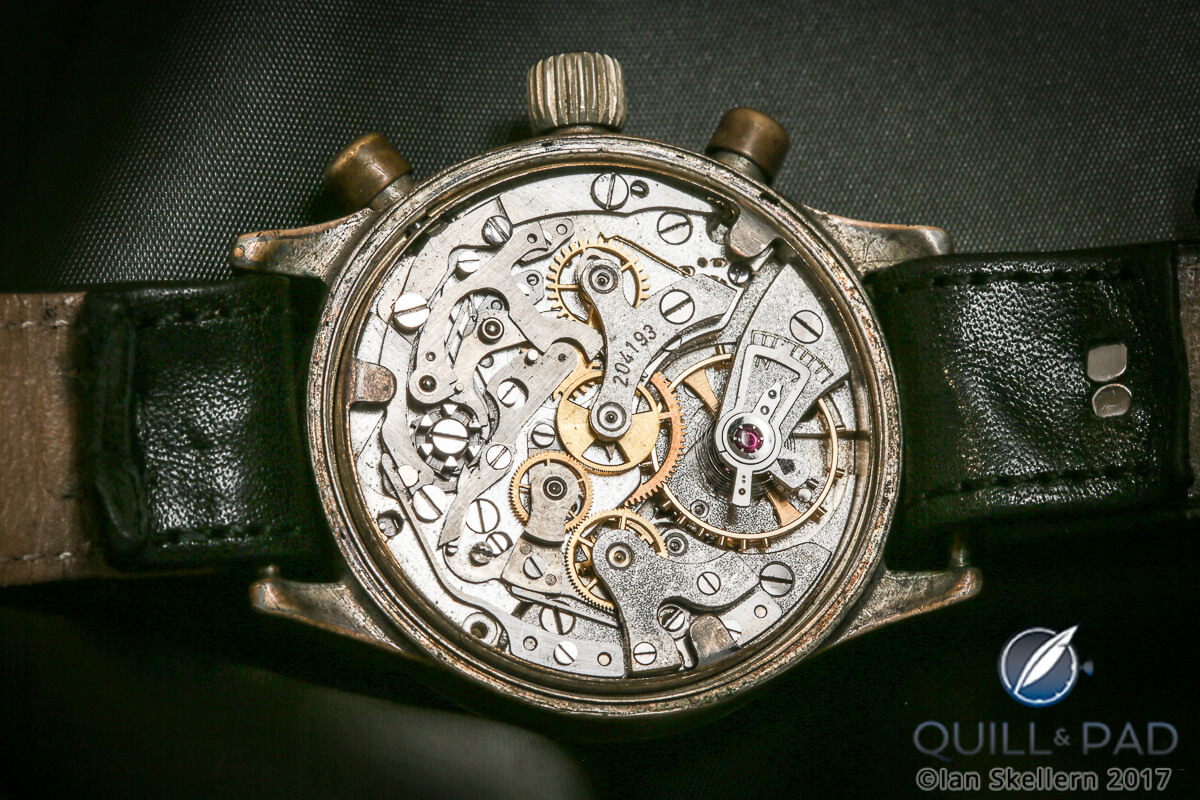
Urofa Caliber 59 in a 1940s Tutima pilot’s flyback chronograph
It is estimated that approximately 15,000 chronographs were produced for the German Air Force, but following the war most were returned upon completion of a pilot’s mission. Early Tutima models are particularly sought after by collectors but are often in either poor condition or heavily restored. Since the case was made of nickel-plated brass, many of them have the brass showing through worn plating.
Hanhart, located in the horologically traditional Black Forest region, manufactured two types of chronographs: two-pusher and a monopusher timers. The chronographs had either rotating or stationary bezels.
Before the 1950s, Hanhart chronograph cases were nickel-plated brass; afterward, Hanhard switched to steel cases. After the war, the Black Forest became part of the French Occupation Zone, so Hanhart continued to produce the chronographs under the brand name Vixa for the French forces.
The post-World War II watches for the German air force have some interesting and (now/still) familiar watch brand, model, and movement names. Here is a representative sampling.
1955: Hanhart 417
The Hanhart 417 was the first watch issued to pilots of the reformed West German Air Force (Bundesluftwaffe) in 1955.
Nearly identical to the wartime flieger chronographs, the 417 had developed a cult-like status, thanks in great part to its association with Steve McQueen, who wore one in the 1960s.
The Hanhart was a decidedly pre-war design for men flying Mach 2-capable F-104 Starfighters. Hence, Junghans was tapped as a second provider of pilot’s watches in 1957.
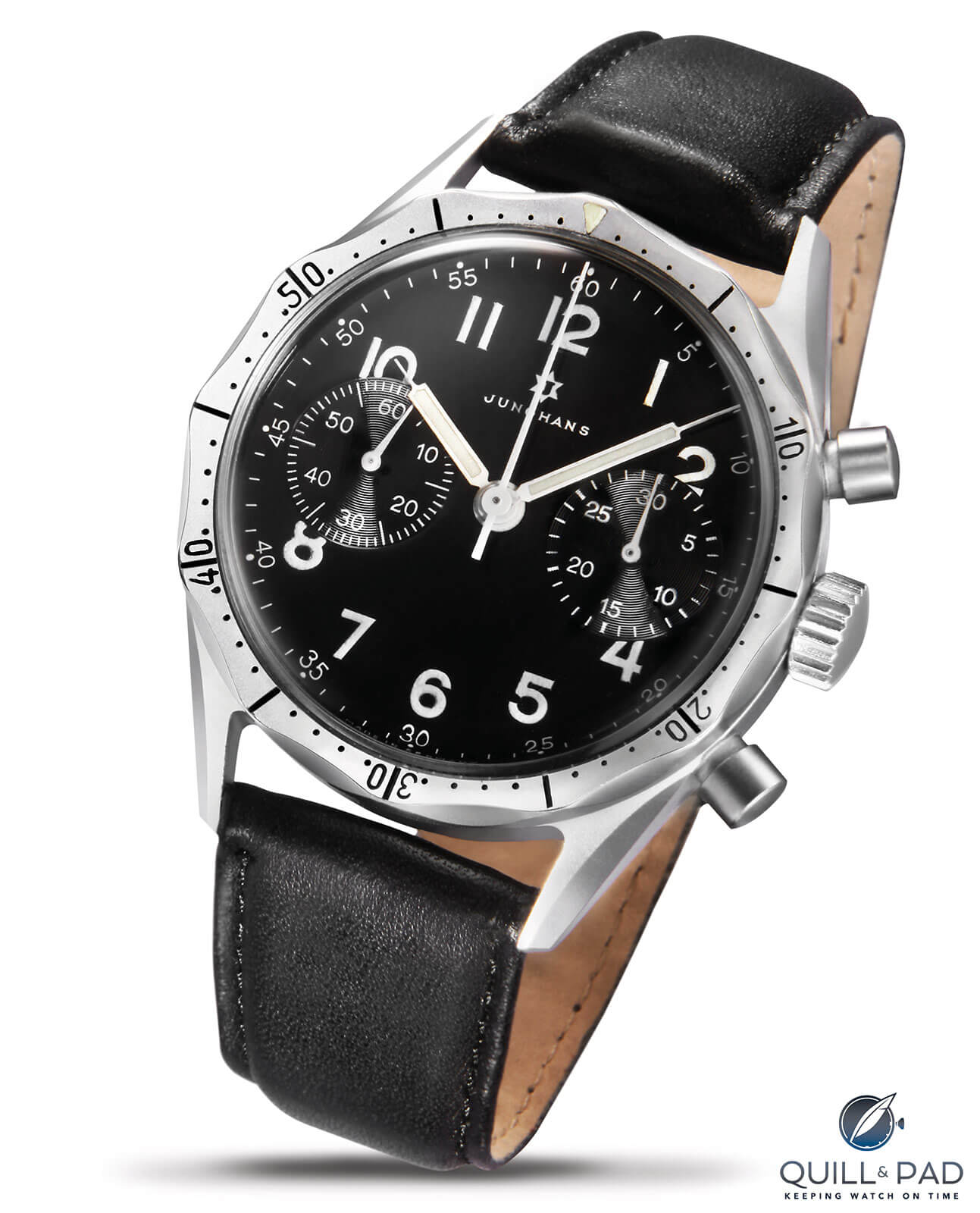
A 1955 Junghans Bundeswehr Chrono powered by Caliber J88 (photo courtesy Junghans)
1955: Junghans J88
Junghans developed the famous column-wheel J88 chronograph movement in 1946. The Black Forest-based company’s watches stand out to this day with the unusual 12-sided bezel.
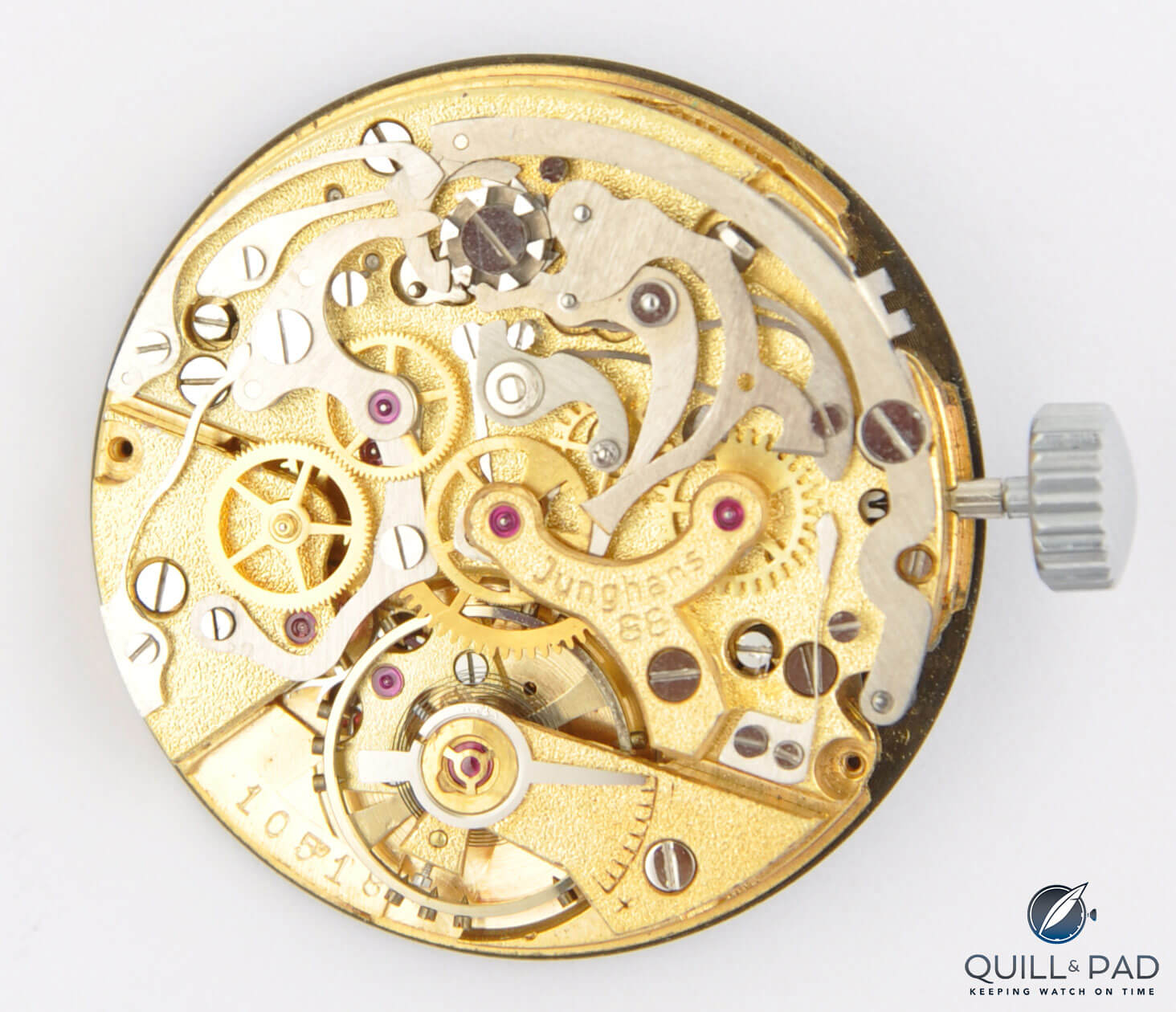
Junghans J88 chronograph movement from 1946 (photo courtesy Junghans)
This Junghans watch was issued to pilots (F-104 Starfighters) from 1957 until it was replaced by the Heuer (Leonidas) Bundeswehr chronographs in 1967.
1967: Heuer-Leonidas Bundeswehr
In 1964 Heuer merged with Leonidas, a competitor who produced watches for the Italian military. The new company, known as Heuer-Leonidas S.A., supplied the Bundeswehr chronograph bearing the Leonidas logo to the Bundesluftwaffe in 1967. It had a 43 mm case and a hand-wound Valjoux 220 movement.
1967: Sinn 1550
Helmut Sinn was awarded a contract to service watches for the German army and took the opportunity to swap out the original Heuer dials with a Sinn logo replacement. So the watch is essentially a Heuer 1550SG with Valjoux 230 movement.
Helmut Sinn purchased Heuer parts and sold several Sinn-dialed 1550SG models to military personnel and later to civilians.
1979: Orfina/Porsche Design
The Orfina Porsche Design “3H military” model was issued to the German military beginning in 1979. This watch was manufactured by Orfina and designed by the Porsche car company design offshoot Porsche Design.
Orfina used the Lémania 5100 automatic movement to power this chronograph. Tom Cruise wore an Orfina “3H military” as “Maverick” in Top Gun. Many watch companies, including Arctos, Sinn, Heuer, Nivada, Tutima, Aristo, and Lémania, cashed in on the popular lug-less design by producing their own versions.
1982: Arctos
Arctos of Pforzheim manufactured a chronograph for the Army Air Corps of the Federal Forces of Germany. The Arctos Bund watch looked just like the Orfina watch and was also powered by the Lémania 5100 movement.
1983 and beyond: Tutima
Tutima received the contract for supplying chronographs to the airmen of the Turkish Army, Airforce, Navy, and the reconnaissance troops of the army and submarine personnel.
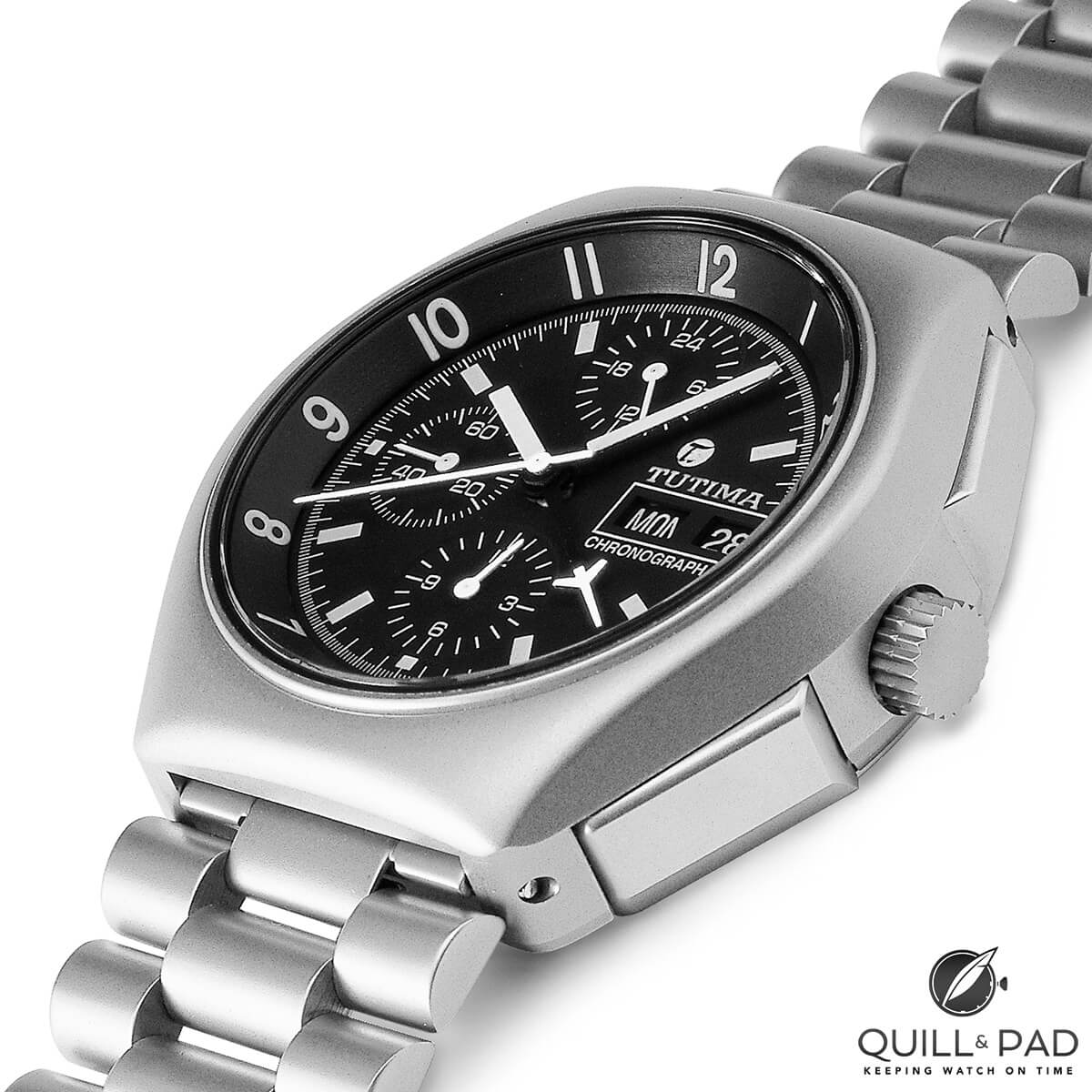
Tutima’s legendary Reference 798, a military chronograph that became the official pilot’s watch of NATO
In 1985 the German army contracted Tutima to create a brand-new military watch, and Military Chronograph 798 was born. It has been part of the standard equipment for Bundeswehr (German armed forces) pilots ever since.
The military prerequisites of Military Chronograph 798 were even stricter than those of the pilot’s watch of 1941. The movements of these watches were based on Lémania Caliber 5100 as well.
Modern fliegers
According my good friend and German flieger expert, Mike Stuffler, contemporary flieger watches still breathe the “kerosene-tainted air of former times.”
Apart from characteristics like legibility, robustness and tool watch appeal, fliegers have their own special aura, making flieger watches somehow immortal and desirable. Most German brands have at least one flieger-inspired watch in their portfolios.
The modern fliegers have embraced practical design for ease in daily wrist wear. They have a similarity to Type A and Type B dial layouts; some have an added date complication; and, finally, they are now smaller so they are fitted with smaller movements like ETA 282x, Valjoux 775x, and Sellita calibers.
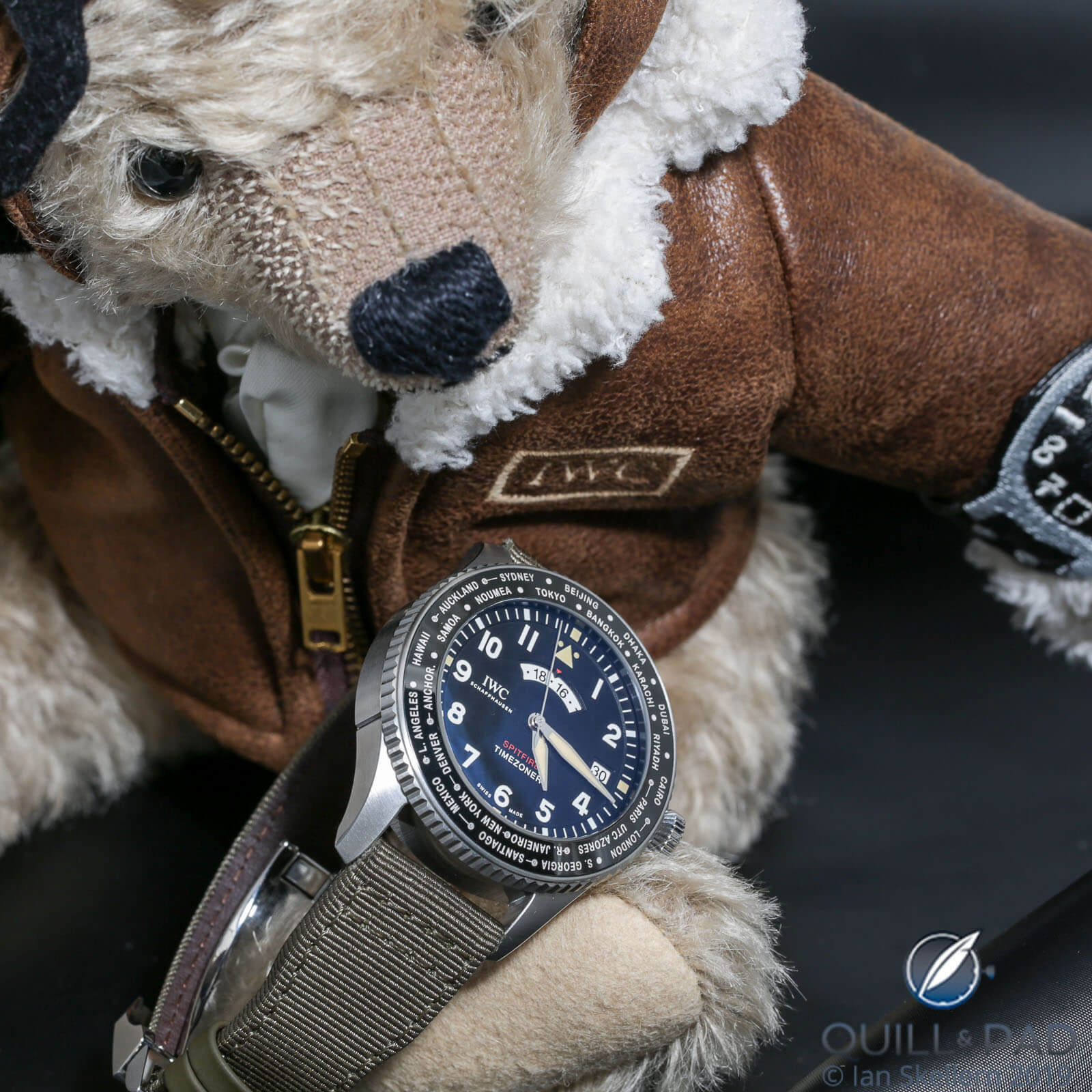
IWC Pilot’s Watch Timezoner Spitfire
There are so many German (and Swiss) brands that produce fliegers, which has become a very popular and fashionable style, that it would be unrealistic to name, let alone provide an overview, of all of them. So I’ll start with original manufacturers of the World War II fliegers. Except for A. Lange & Söhne, the other original manufacturers – IWC, Laco, Stowa, and Wempe – still make homage fliegers.
Tutima and Hanhart also continue to make modern flieger chronographs. These brands have the credibility of their histories and design elements despite changes in ownership and production processes.
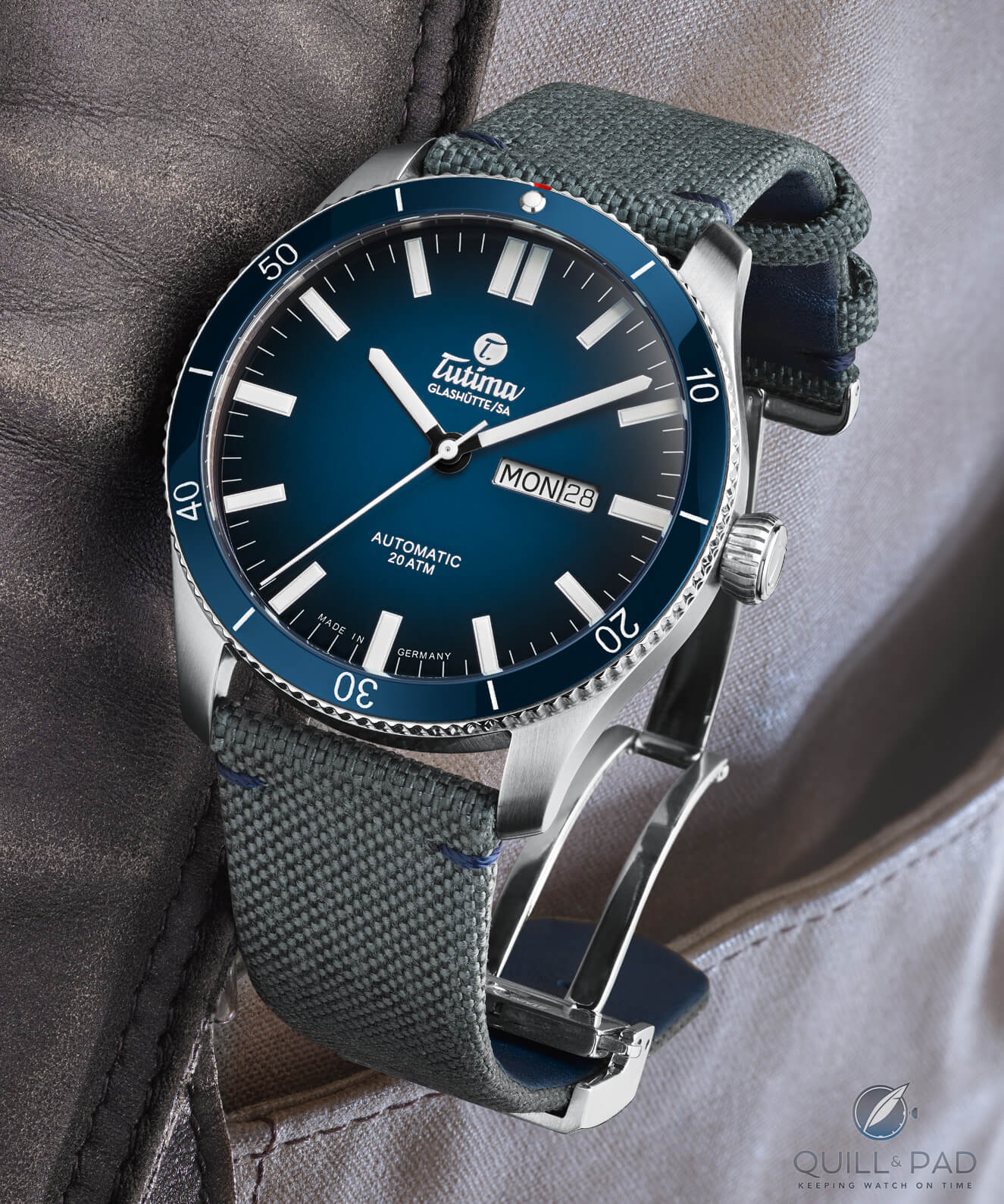
Tutima Glashutte Grand Flieger Airport with blue dial
There is a new German watch standard for pilot’s watches – DIN 8330 – which came about at the request of Sinn in March 2016; Stowa also adheres to this standard. It is important to mention DIN 8330 as it is a well-intentioned standard for the certification of a modern flieger.
This standard certifies a watch for fast, clear legibility of the dial both during the day and at night; the ability to operate the watch even while wearing pilot’s gloves; temperature changes; impact load and centrifugal force; and good accuracy between -15°C and +55°C.
In addition, DIN 8330 also defines more precise criteria, including vibration resistance, magnetic field protection, resistance to corrosive liquids commonly encountered in the aviation industry (fuel, lubricants, cleaning fluids, and de-icer), and compatibility with night-vision equipment.
After Helmut Sinn sold Sinn in 1994, he purchased an old Swiss brand, Guinand. He retired in 2006 at the age of 90 – passing away in 2018 at the ripe old age of 101 – and Guinand is now under new ownership and continues to make interesting fliegers.
Bruno Belamich and Carlos Rosillo, who worked under the mentorship of Helmut Sinn at the beginning of their careers, launched square instrument-based fliegers in 2005 with Bell & Ross: their now iconic BR 01 Instrument launched an entire collection and still remains one of the brand’s most popular models today.
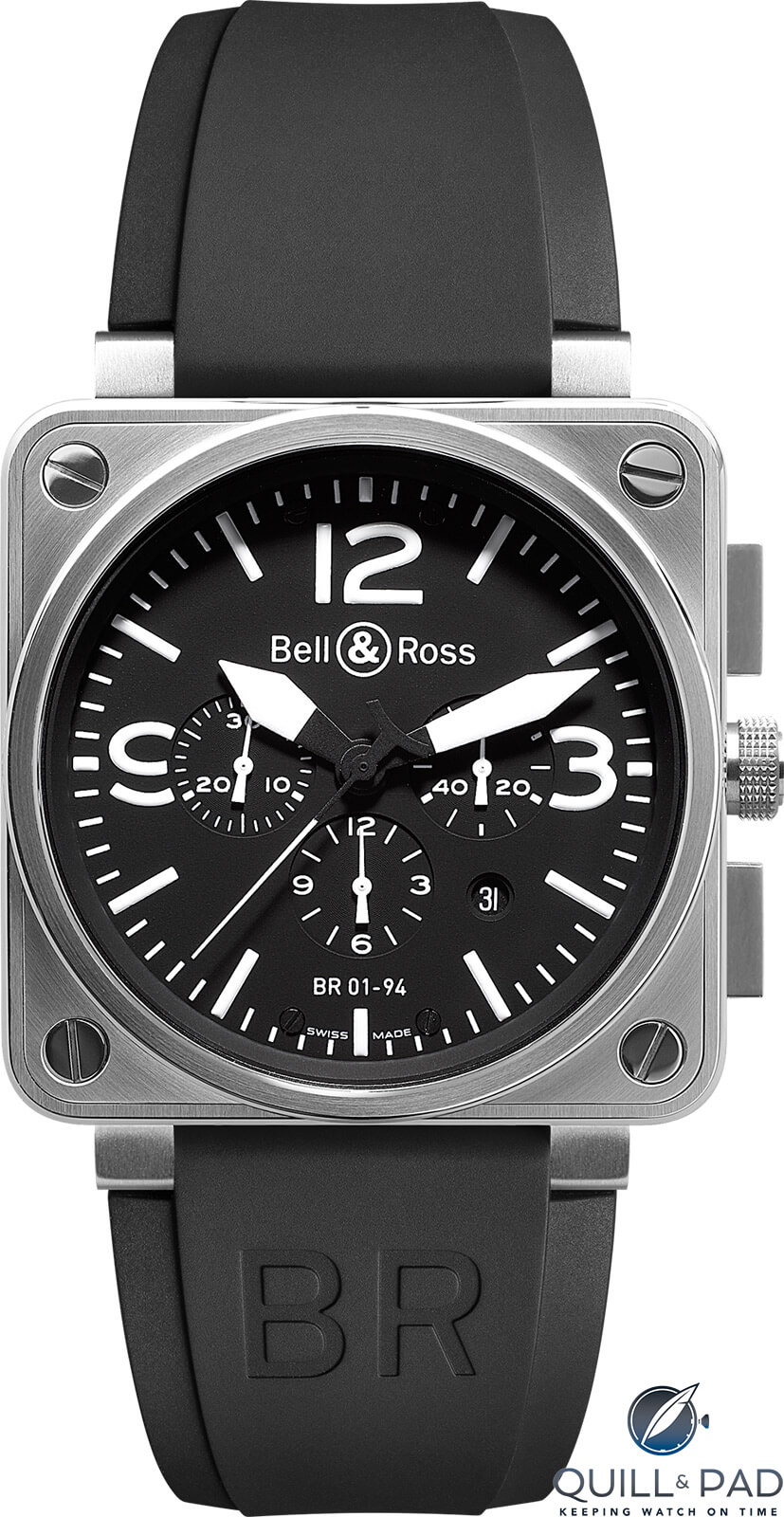
Bell & Ross BR 01-94 chronograph
And in its recent past, Glashütte Original made great homage fliegers with in-house movements.
Other German brands making modern fliegers are Damasko, Aristo Vollmer, Archimede, Dekla, Junghans, and Mühle Glashütte. Watch companies outside of Germany noteworthy when discussing military and aviation watches are Zenith, Longines, Breitling, Breguet, Heuer, Dodane, Omega, Bremont, Fortis, and Alpina.
Some of them played important roles for French, British, and American pilots. Look for a follow-up article focusing on the French Type XX chronograph watches coming soon!
Source used: Militäruhren – Military Timepieces by Konrad Knirim, second edition, 2002
* This article was first published on July 11, 2020 at A Crash Course In Flieger (Pilot) And B-Uhren (Navigator) Watches Covering Both Historic And Modern Examples (A Pilot’s Watch Photofest!).
You may also enjoy:
‘Made In Glashütte’ Vs. ‘Made In Germany’: What Puts Them Together, What Sets Them Apart
90 Years Of Tutima: An Abbreviated, Complete History
Made In Germany: The Glory Of Glashütte
Tutima Tempostopp Flyback Chronograph: A Moving Homage To The History Of Glashütte

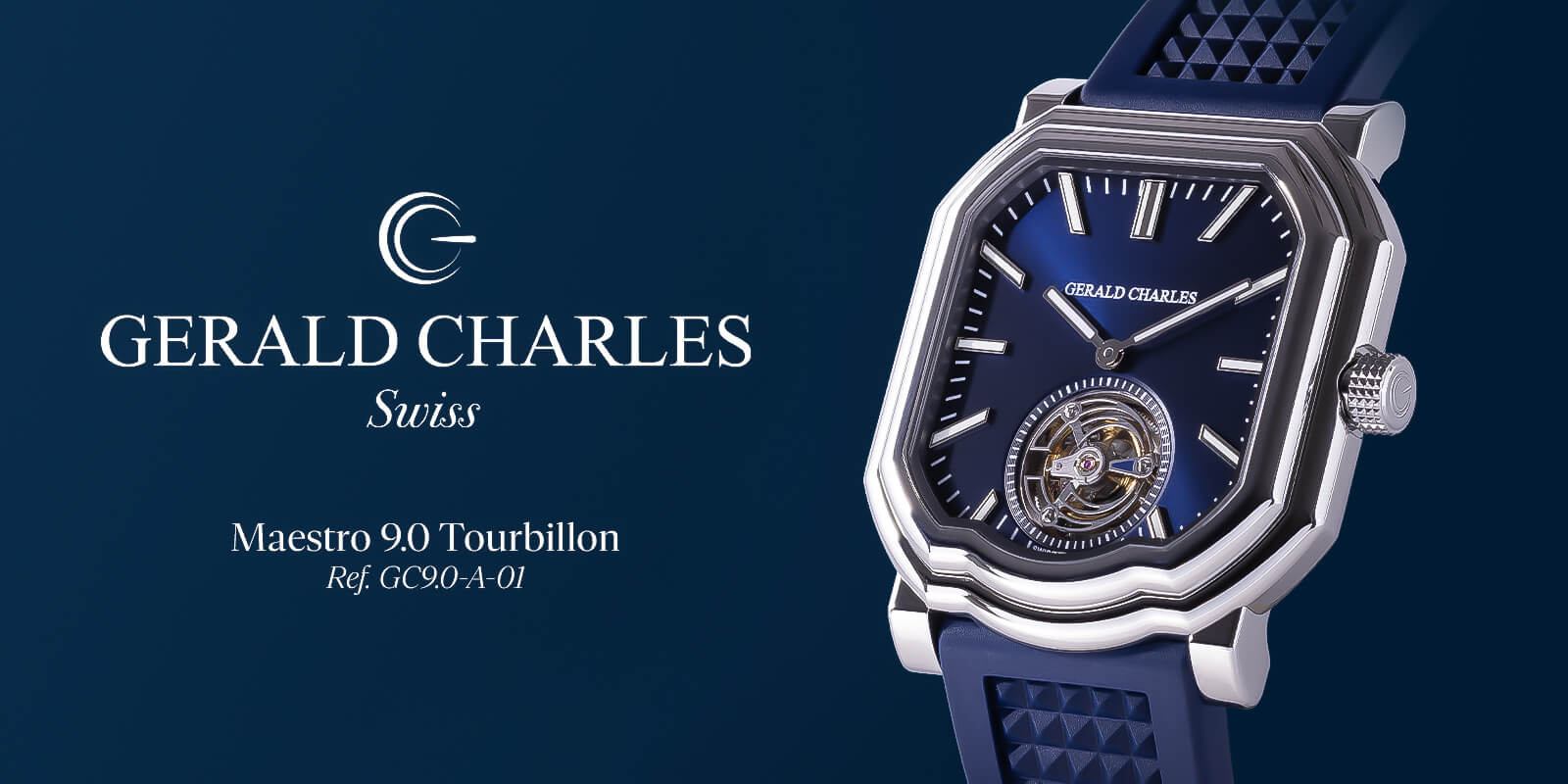
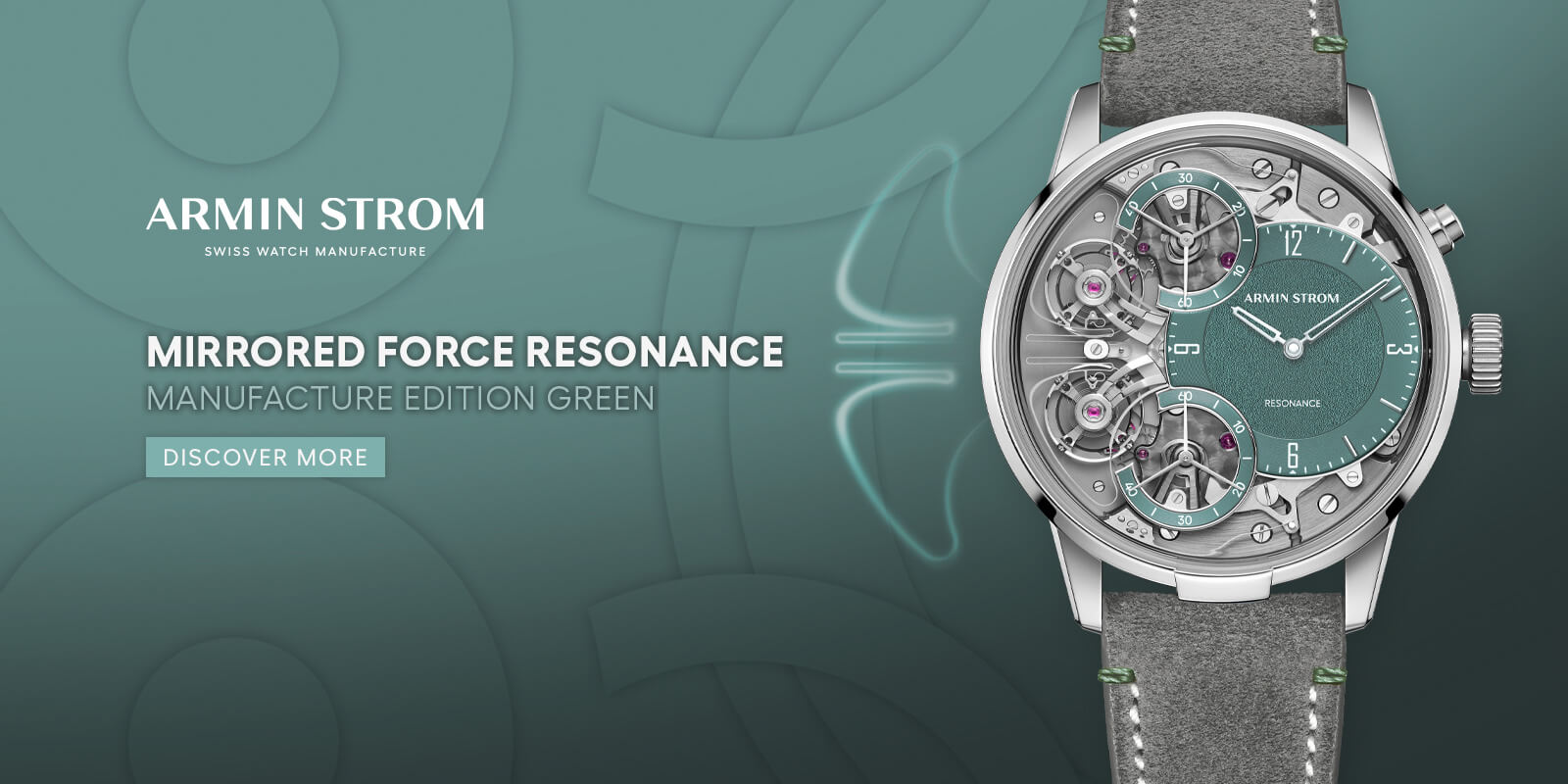
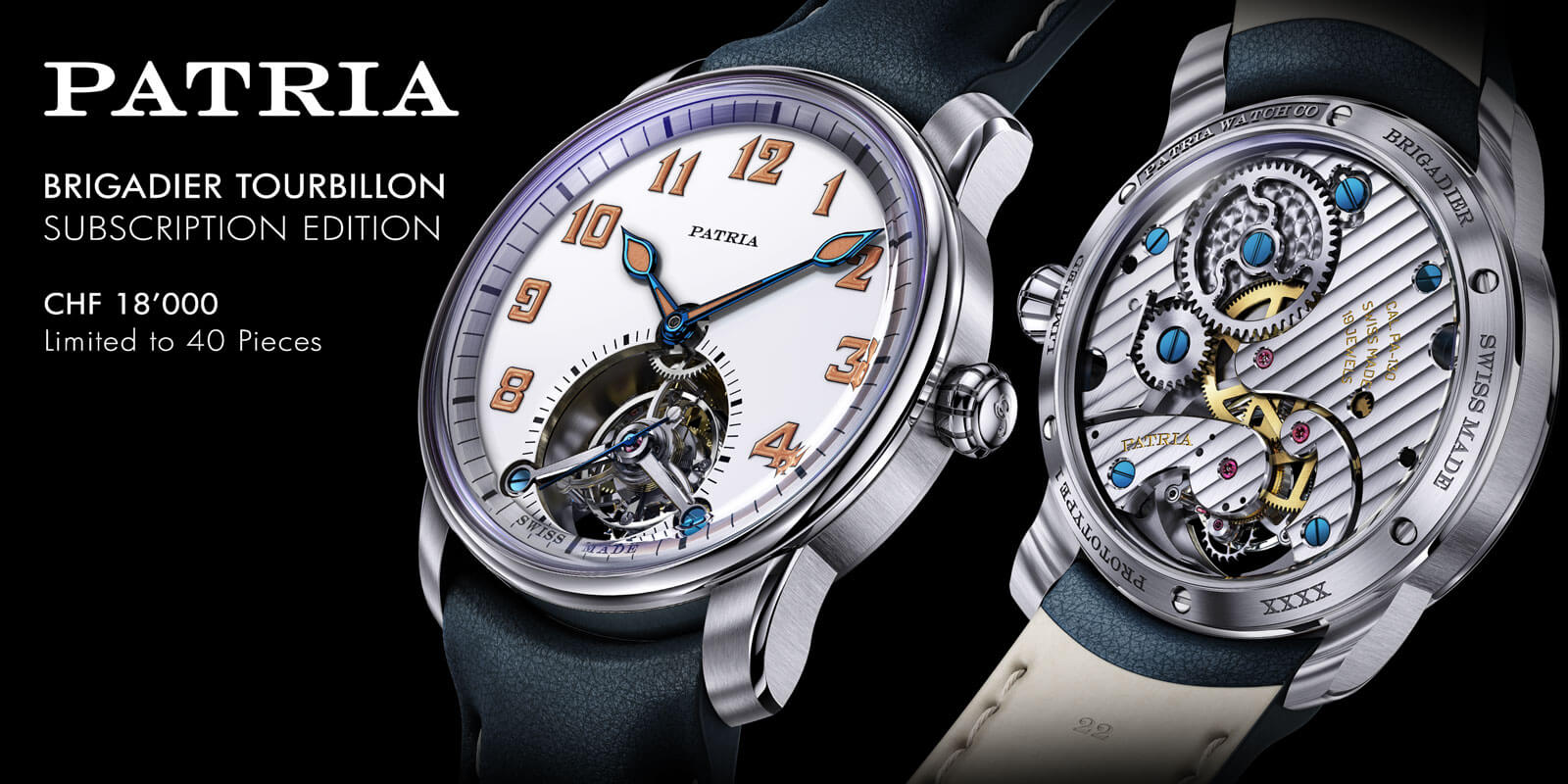


Leave a Reply
Want to join the discussion?Feel free to contribute!